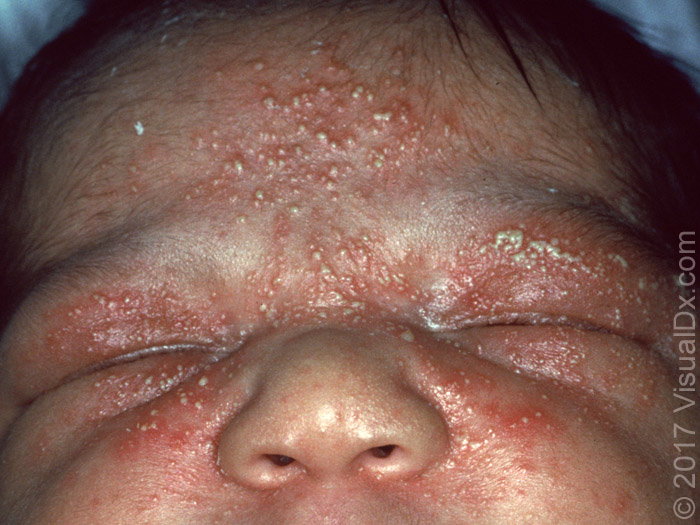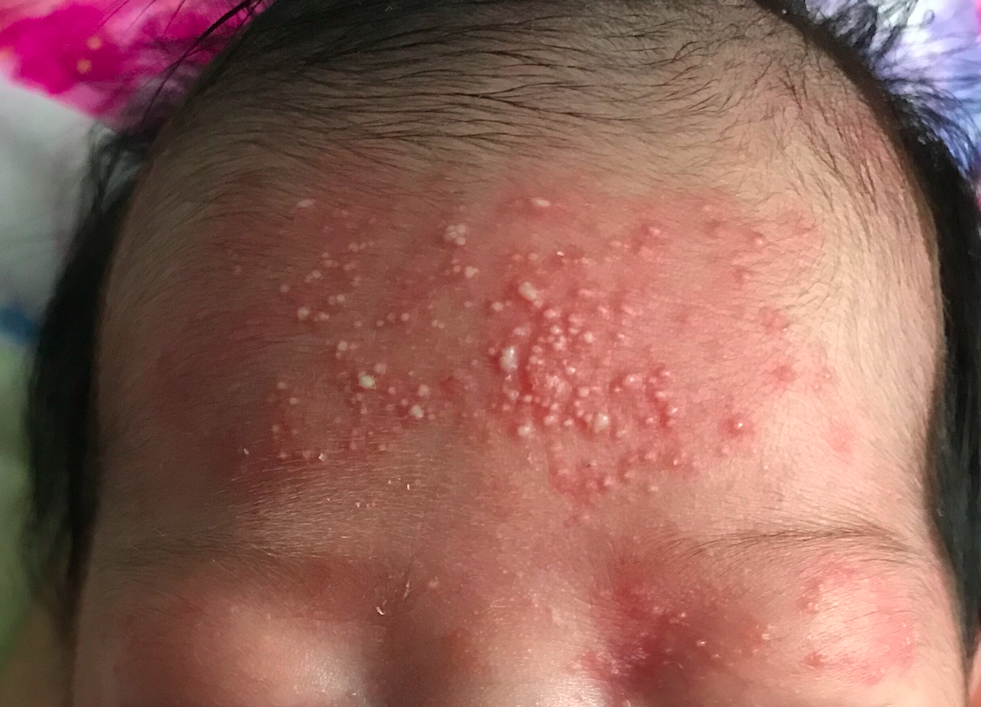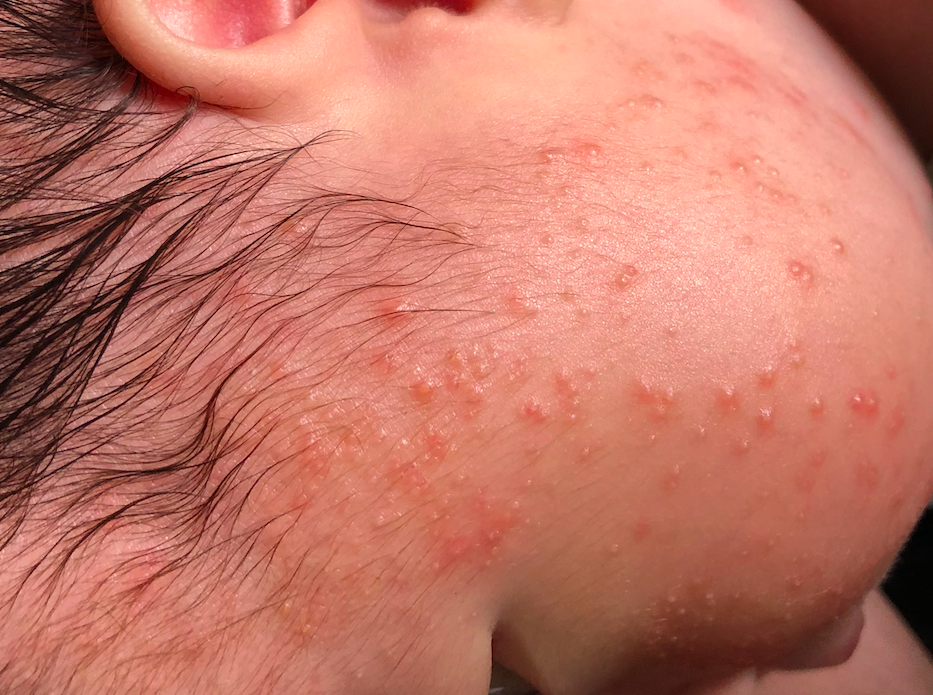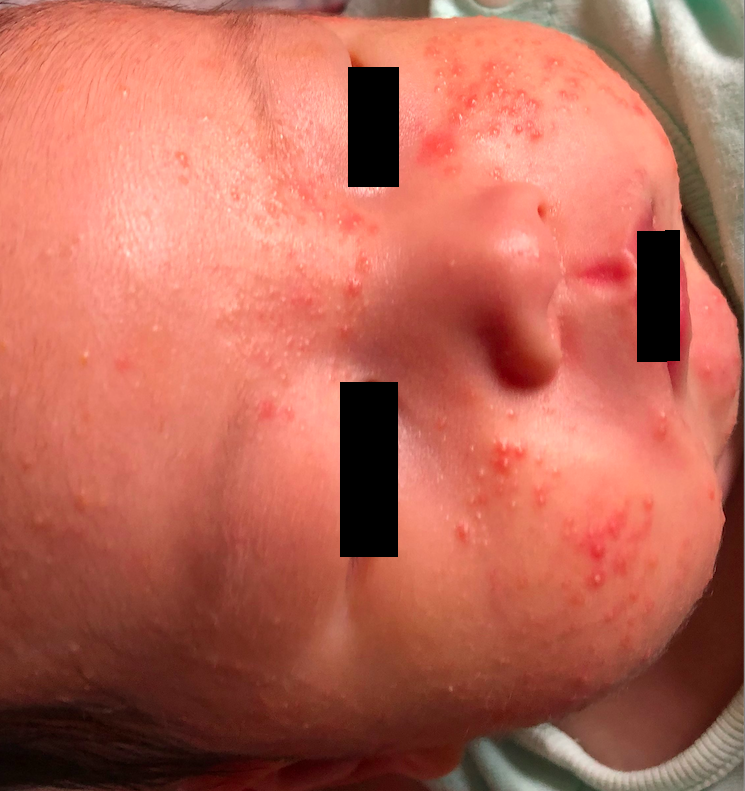Neonatal cephalic pustulosis
OVERVIEW
What is neonatal cephalic pustulosis?
Neonatal cephalic pustulosis was previously misdiagnosed as "neonatal acne." It has since been distinguished from "neonatal acne" because the rash is not caused by maternal or endogenous androgen stimulation of sebaceous glands.
It may be an inflammation caused by bacterial colonization of the skin.
What are the symptoms of neonatal cephalic pustulosis?
It mainly presents as facial papules, papulovesicles, and larger pustules.
Which department should be consulted for neonatal cephalic pustulosis?
Neonatology, pediatrics, or dermatology.
What is the prognosis for neonatal cephalic pustulosis?
The condition is generally mild and resolves on its own within weeks or months.
Where does neonatal cephalic pustulosis commonly occur?
It mostly appears on the face and occasionally affects the scalp.
How is neonatal cephalic pustulosis treated?
No specific treatment is usually required, and home care is sufficient. In severe cases, 2% ketoconazole cream or 1% hydrocortisone cream may be applied.
Does neonatal cephalic pustulosis increase the risk of acne during adolescence?
Infants with neonatal cephalic pustulosis do not have an increased risk of developing acne during adolescence.
Is neonatal cephalic pustulosis common?
Neonatal cephalic pustulosis is uncommon. Due to past confusion with "neonatal acne," the combined incidence was estimated at around 20%. However, neonatal cephalic pustulosis is actually rarer in clinical practice.
Are neonatal cephalic pustulosis and neonatal acne the same condition? What are the differences?
Neonatal cephalic pustulosis (Figures 1 and 2) and neonatal acne (Figures 3 and 4) are not the same condition.
Both can occur in the neonatal period and have similar presentations, such as papules, papulovesicles, and pustules. However, "neonatal acne" consists of typical acne-like lesions, including facial comedones, inflammatory papules, and pustules, which are generally smaller than those of "neonatal cephalic pustulosis" and may sometimes be accompanied by nodules.




Neonatal cephalic pustulosis is caused by Malassezia colonization and can be treated with topical 2% ketoconazole cream (or left untreated).
Neonatal acne, on the other hand, is caused by maternal and endogenous androgen stimulation of sebaceous glands, making it more common in boys and also influenced by bacterial colonization. Topical benzoyl peroxide, erythromycin, or retinoids may be effective.
SYMPTOMS
What are the common manifestations of neonatal cephalic pustulosis?
Neonatal cephalic pustulosis mainly occurs on the face, most commonly on the cheeks and forehead. The rash primarily presents as inflammatory papules and pustules, without acne comedones.
Is neonatal cephalic pustulosis serious?
The condition is generally mild and resolves on its own within weeks or months.
Where does neonatal cephalic pustulosis commonly occur?
It primarily affects the face, most frequently the cheeks and forehead, and sometimes the scalp.
What complications can arise from neonatal cephalic pustulosis?
With proper care, neonatal cephalic pustulosis does not leave any lasting issues.
CAUSES
What is the cause of neonatal cephalic pustulosis?
The exact pathogenesis of neonatal cephalic pustulosis remains unclear. It is currently believed to stem from inflammatory reactions caused by skin colonization of Malassezia species. It was once mistakenly thought to result from maternal and endogenous androgen stimulation of the baby's sebaceous glands, hence the misnomer "neonatal acne."
Currently, Malassezia species are also considered a contributing factor in neonatal acne, so whether neonatal acne and neonatal cephalic pustulosis are fundamentally related remains debated.
Is neonatal cephalic pustulosis contagious?
No, it is not contagious.
Is neonatal cephalic pustulosis hereditary?
Neonatal cephalic pustulosis is not hereditary, and there is no family history associated with it.
DIAGNOSIS
How is neonatal cephalic pustulosis diagnosed?
When diagnosing neonatal cephalic pustulosis, doctors primarily rely on the characteristic facial rash morphology and the age of onset.
Which diseases can neonatal cephalic pustulosis be easily confused with? How to differentiate them?
-
Neonatal cephalic pustulosis is often confused with neonatal acne, as these terms have been interchangeably used by clinicians. A detailed differentiation is provided in the earlier introduction.
-
Neonatal cephalic pustulosis can also be confused with miliaria (prickly heat). Miliaria does not require specific treatment and typically resolves quickly when the baby is placed in a cooler environment with measures to reduce sweating, which helps distinguish it from neonatal cephalic pustulosis.
TREATMENT
Can neonatal head pustulosis heal on its own? How long does it take to recover?
Neonatal head pustulosis is generally a self-healing condition. The symptoms are usually mild and can resolve on their own within weeks or months.
How is neonatal head pustulosis treated?
Neonatal head pustulosis is typically mild, self-limiting, and does not leave scars, so treatment is usually unnecessary. For visibly inflamed rashes, 2% ketoconazole cream or 1% hydrocortisone ointment may be applied under a doctor's guidance.
DIET & LIFESTYLE
Is neonatal cephalic pustulosis related to breastfeeding?
Neonatal cephalic pustulosis is not related to breastfeeding. Breast milk contains all the nutrients and immunoglobulins necessary for a newborn's growth, and breastfeeding should be encouraged.
What should parents pay attention to in daily care for infants with neonatal cephalic pustulosis?
Proper care is essential for neonatal cephalic pustulosis:
-
Ensure the baby stays in an environment with moderate temperature and humidity. Excessive heat may worsen the symptoms.
-
Clean the baby's skin with water or mild baby soap. Generally, washing the face once with warm water is sufficient. Overwashing may damage the skin barrier and aggravate the condition. Gently dab with a soft sponge or cotton towel—avoid rubbing harshly.
-
Avoid applying oily lotions on the face. Instead, try non-greasy moisturizers. Initially, test the cream on a small patch of skin and monitor closely to ensure it doesn’t worsen the condition. If effective, it can be applied to other areas.
-
Do not squeeze the pustules, as this may lead to bacterial infection and spread.
-
Parents should remain patient and avoid excessive anxiety. Neonatal cephalic pustulosis typically resolves on its own within weeks or months.
PREVENTION
Can neonatal cephalic pustulosis be prevented? How to prevent it?
The mechanism of neonatal cephalic pustulosis is unclear, so there is no way to prevent it. However, even if a baby develops it, it will heal on its own. Parents should be patient and avoid excessive anxiety.
How to prevent complications in infants with neonatal cephalic pustulosis?
Proper care is essential. Use a soft towel and wash the face with warm water. Do not squeeze the pustules to avoid bacterial infection and spreading. The condition will resolve on its own without leaving any scars.
